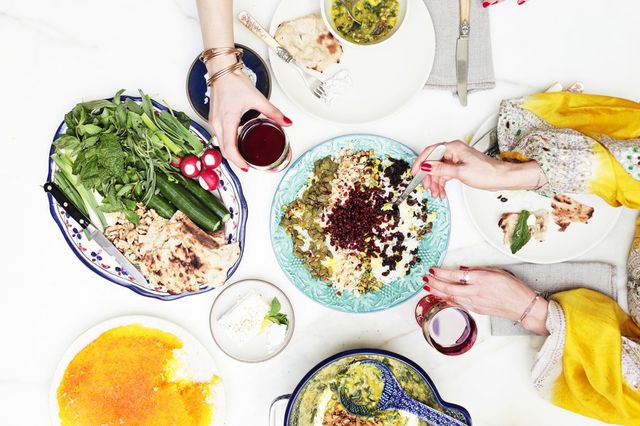The intoxicating aroma of Persian foods such as kebab filled the room, and the attendees were eager to learn Persian and Hebrew conversational skills. Jews came, Persians came, and even some who were neither participated.
Today, Iran and Israel are known to the world as adversaries, even though they were once allies. My family — as well as many other Iranian families who had lived in Iran for centuries — were suddenly forced to flee Iran during the Islamic Revolution. Even though I have never been to Iran myself and my family left their home country behind, I still have always felt a connection to my Persian heritage.
Persian language and culture are important parts of the UCLA campus, as well as of Los Angeles in general. (The city is nicknamed “Tehrangeles” for a reason!) Walking down Westwood Blvd. (unofficially named “Persian Square”) is like stepping into mini-Tehran, with a multitude of Persian restaurants, markets and shops. UCLA, too, has a thriving Persian community, and many non-Persians have been inspired to learn about the Persian language. This is how the Persian-Hebrew Café was created. It was an open space with delicious food where people of all backgrounds had the opportunity to learn Persian and Hebrew languages simultaneously.
The motivation behind these “cafés” is to bring two cultures together in a fun and laid back environment through learning about the languages. There has been a Chinese-Hebrew Café and for the future, an Arabic-Hebrew Café and a French-Hebrew Café are planned.
The Persian and Hebrew languages are more similar than one might think. In Persian, the greeting for hello is Salam, and in Hebrew it is Shalom — both greetings from phrases meaning “Peace be on you.” Persian is an Indo-European language, while Hebrew is a Semitic language. However, Persian, unlike Hebrew, is a genderless language, similar to other languages like Finnish and Japanese.
The relationship between Persians and “Hebrews” started approximately 25 centuries ago when Cyrus the Great gave the Jews and other religious minorities freedom of religion, allowing them to return to their land and rebuild the temple in Jerusalem. He was the only non-Jewish king who was seen as a positive, somewhat messianic figure to the Jews.
Later, in the 20th century, after a long period of isolation in the mahallehs, or ghettos, the Shah liberated the Jews and welcomed them to move into the capital of Tehran and encouraged them to assimilate into Persian society. Israel at one point was the closest ally of Iran in the Middle East and had a good relationship under the Shah’s rule. Today, although Iran and Israel are seen as adversaries, Persian and Hebrew continue to coexist and are fused together by the large community of Persian Jews. As a Persian Jew myself, it was nice to see two components of my identity coming together in front of me.
At the Café, Professor Hagigi, who has been teaching Persian language and literature at UCLA since 1988, taught the attendees about the history of Iran and Iranian culture. Hagigi also taught attendees how to say a few Persian phrases, the origins of the language, and, of course, went over different kinds of delicious Persian food.
I spoke to Martin Chan, one of the coordinators of the event, who is receiving his PhD in Hebrew at UCLA. Chan explained, “I think that there is a deep historical linguistic connection between Persian and Hebrew due to thousands of years of peaceful coexistence and mutual benefit. Jews were treated well under Persian rule, and there are many words in ancient Hebrew that are of Persian origin. Interestingly, the longest word in the Hebrew Bible, אֲחַשְׁדַּרְפְּנִים, meaning satraps, is of Persian origin. Modern Hebrew and Farsi share a modern linguistic connection due to the large number of borrowings from Arabic. For instance, at the Café, we taught the students essential Israeli phrases, such as Yallah! (‘Let’s go!’) and wallah (‘Really?’), and these are slang words that come from Arabic which also exist in Farsi!”
Another one of the students who helped organize the Persian-Hebrew Café was Jessica Behmanesh, a member of the Student Leader Council for the UCLA Leve Center for Jewish Studies. Behmanesh described the reasoning for the connection between Persian and Hebrew: “Persian Jews have learned to blend the two tongues throughout history. In fact, today there exists a language known as Judeo-Persian. It is Persian vocabulary written in Hebrew script. I think that Jews created this language partly to create a connection between Persian and Hebrew. Persian is a very poetic and romantic tongue, and the Hebrew language is considered something sacred. Perhaps Persian Jews admired both. Rather than relinquish one for the other, they combined them together.”
Below are some useful phrases to learn in Persian! Enjoy!
Persian Food: Bread – Noon, Water – Ab, Rice – Pollo, Crunchy Rice –Tahdig
Hello – Salam
How are you? –Chetori? or To chetori?
I’m good, thank you – Khoobam, merci
Do you like me? – To mano doost dari?
Yes, I like you very much –Balleh! Man to ra kheyli doost daram
Do you speak Persian? – To Farsi harf mizani?
Happy Holidays! – Eydeh shomah mobarak!
Hurry up! – Yallah!
—
For those interested in improving Hebrew skills, Hebrew Conversation Hour takes place every Friday at Hillel from 1:30 to 2:30 pm, and is open to everyone!

